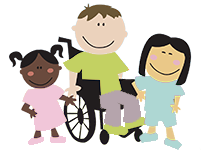Children are making huge advances in oral communication despite hearing loss thanks to great improvements in technology and early identification. It is now very feasible that a child with severe hearing loss can speak, learn oral language, and go to his/her local public school.
Hearing Loss Types:
Conductive loss: This loss occurs when the outer or middle ear fail to work. Sounds are “blocked” and not carried to the inner ear to be processed. Many times conductive losses are treatable with medicine or surgery. Ear infections can be a common cause of conductive loss as fluid builds up in the middle ear.
Sensorineural loss: This occurs when there is a problem to the inner ear or auditory nerve. This is the most common type of hearing loss. This type of loss is not surgically treatable but can be helped with hearing aids or cochlear implants. A sensorineural loss can occur in one or both ears and can range in degree and frequency of loss.
The human ear can hear sounds ranging from a low frequency of 125 Hz to a high frequency of 8000 Hz. Speech sounds occur across all of these frequencies. The severity of hearing loss is measured in decibels ranging from 0-120 dB. In children, normal hearing ranges from -10-15 dB. A slight hearing loss ranges from 16-25 dB. A mild loss ranges from 26-40 dB. A moderate hearing loss ranges from 41-55 dB. A moderately- severe hearing loss ranges from 56-70 dB. A severe hearing loss ranges from 71-90dB, and a profound hearing loss ranges from 90+ dB. It is very common that hearing loss can vary in severity across the different frequencies so that they hear some frequencies better than others.
Hearing Aids and Amplification:
Adults and children with sensorineural hearing loss are most typically fitted with hearing aids. Audiologists can tune hearing aids to make use of the sounds a patient hears well while increasing the sounds of the frequencies he/she does not hear as well.
If a patient’s loss is even too severe for hearing aids, a cochlear implant is an option. Cochlear implants can be implanted in children as young as one year of age. Candidates for a cochlear implants have a severe hearing loss and do hear enough of the speech spectrum through hearing aids alone. Cochlear implants are different from hearing aids. While hearing aids amplify sounds, cochlear implants bypass the part of the area that is damaged and stimulate the auditory nerve directly.
Speech and language therapy is critical for children and adults with hearing loss. In children, speech-language pathologists trained in working with children with hearing loss help their patients learn to become aware of sounds, identify and recognize words, sounds, and objects, and begin comprehending oral language. In adults, they can assist in aural rehabilitation. They can teach adults communication strategies to maximize their hearing loss. If your child or loved one has been identified with a hearing loss, it is very important to get a speech-language pathologist involved in his/her treatment to fully maximize their oral language and communication.
